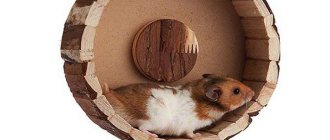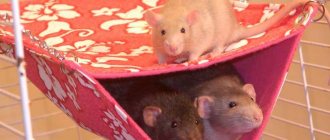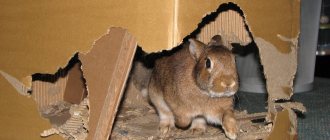When I bought a hamster, I put newspapers in his house - he really liked it, he used to cover the entrance and the window all the time, it was soft and cozy for him - he made a nest for himself. I recently learned that newspaper paint often poisons hamsters. I put plain paper in the hamster’s house and she threw it all out of the house. What else can you put a hamster in the house so that he feels comfortable there and can make a nest for himself?
The hamster loves to carry everything into the house and build a nest there. We bought a special house for our house and filled the cage with sawdust on the ground floor and a piece of toilet paper in the house itself. It is not harmful to the hamster's health. He is completely satisfied, wraps himself in paper and sleeps. Just change it when you clean the cage.
I bought my dwarf a hamster mansion like this.
buy regular sawdust, they also sell wooden houses for rodents. They are not expensive, and there are various options
The hamster definitely needs to pour filler into the bottom of the cage - they sell “Golden Cat” corn filler and some other stuff. I like “care fresh” - paper filler. It's quite expensive, but I like it the best. But not pine needles - hamsters are allergic to pine needles!
And specifically regarding your question, what to put in - napkins. Tear ordinary white paper napkins into shreds (not very small, medium) or handkerchiefs (without any aromas/tastes/smells!).
The hamster will use them to insulate his house if he needs it. Don’t force him, he doesn’t bring napkins to him - that means he doesn’t need it.
The bottom of the house can be covered with sawdust or sand if it is closed on the sides. Place some twigs and wooden objects in the house. My hamster had a piece of driftwood that was once in an aquarium. The hamster liked to study it and climb on it. You can put wooden ice cream sticks, unnecessary wooden kitchen utensils. Something on which he will jump, swing, run, i.e. lead a healthy active lifestyle. And at the same time, all this will be useful for teeth, since they constantly need to be ground down. And life will be much more fun for him if the environment is varied. And from time to time you will give him something new from “furniture”.
It seems to inexperienced livestock breeders that a glass jar with sawdust or chopped paper is enough for a pet hamster for coziness and comfort. In fact, this is far from true; a house for a hamster is as integral an attribute of the cage as a feeder and drinking bowl. This is where rodents prefer to rest and sleep. In modern pet stores, you can easily find a cozy “housing” for a dzhungarik or a Syrian hamster, depending on the financial situation of the breeder and his preferences. However, before making a planned purchase, it is important to learn a few simple rules.
When do hamsters dream and why do they need a house?
In the wild, rodents like to build their nests in small shelters: hollows, burrows, recesses, nests. They are nocturnal; during the day, rodents like to sleep. To do this, they choose small spaces that provide the animals with safety, comfort and the necessary thermoregulation.
For pets, their owners have to take care of their comfort. In order for your pet to rest peacefully after nightly “walks” on the wheel, it is advisable to equip its cage with a small house.
In this case, two unforeseen situations may arise. If the hamster does not sleep in the house, there are reasons for this. As a rule, rodents reject housing whose smell they do not like. After washing the home, it should be placed in a place where the animal curls up and rests.
The hamster may simply be hot (especially in the summer), and he chose a more ventilated place. There is no need to worry that the hamster has stopped sleeping in the house if the animal is healthy, active and eats the food offered with appetite. Let him sleep where he is comfortable.
There are also the opposite cases: the pet has become so comfortable in its secluded place that it does not leave the house. This happens when the animal adapts to new conditions, or is very frightened. However, if the "fluffy" does not come out of hiding to eat or drink, then some kind of disease may be the cause. In this case, it is necessary to lure the hamster out of the house or carefully remove it from there by lifting the structure. The animal must be carefully examined and, at the slightest suspicion of illness, shown to a veterinarian.
Newspapers
Apparently, this still relatively popular filler option is a legacy of those times when hamsters were kept in three-liter jars and fed cabbage and bread crusts. But if at that time such a choice for caring for an animal could still be explained (after all, there was no choice at all, other options for fillers used were no better than scraps of newspaper), now it seems simply amazing.
And it’s not just that printing ink, to put it mildly, is harmful to the hamster. This filler option does not fulfill its main function: it does not retain moisture and odor at all. And as a result, the little animal successfully spoils its health while it sleeps in newspaper scraps or chews them into shreds, and the smell from the cage is the same as from a cage without any filler at all.
Photo: Depositphotos
In other words, this filler does not have a single positive characteristic at all, since it is difficult to call it a filler.
How to equip a pet house
A rodent's house serves as a fortress. Here he likes to relax, build nests, and hide supplies for a rainy day. It is important to remember that the hamster arranges his home according to his own taste. The owners can only choose a house model for their pet and help him in “decorating” the home by throwing napkins, shavings, sawdust, paper, and shreds into the cage. From the proposed options, the animal will independently choose what suits it best.
Some owners prefer to put cotton wool in their pet's house. This material can be used, but only in small quantities. Otherwise, the cotton wool will get tangled between the small fingers of the rodent and cause a lot of inconvenience to the baby.
You can make a house with your own hands from available materials (wood, fabric, ceramics, plastic, plant fibers, wicker), however, it is better to purchase a finished product at a pet store. Nowadays, there are various options for hamster houses.
It is important that the home for the baby is safe, has a stable structure, and does not have sharp corners. And the housing material in which the hamster will rest must be free of all kinds of toxic impurities. Some owners create houses out of cardboard for their pets, but such structures are impractical, and the “fluffies” chew them up pretty quickly.
The size of the home directly depends on the size of the pet. For Djungarian hamsters, the “bedroom” should be smaller than for Syrians. When buying a home for a pet, it is important to remember that the animal can grow. And if the same “Syrian” buys a “bedroom” for a dzhungarik, then one day you may encounter the problem that the hamster is stuck in the house. This situation may seem funny to some, but a frightened animal will definitely not be laughing. From such experiences and pressure on vital organs, the rodent may die.
Most rodent houses do not have a bottom, so cleaning them is not difficult; you just need to lift the structure.
How do hamsters like to sleep?
Rodents love to sleep in small shelters: burrows, hollows, nests - sleeping in a small space is familiar and natural for these animals. Small rooms provide the animal with the necessary thermoregulation and a feeling of comfort.
Different models of hamster houses satisfy the needs of pets and the aesthetic needs of owners. Design ideas allow you to turn your pet's sleeping place into a cage decoration. A house for a dwarf and a Syrian hamster can be made from:
- ceramics;
- fabrics;
- plastic;
- wood;
- vines;
- plant fibers.
The accessory is inexpensive, but you might be more interested in making a hamster house with your own hands.
Plastic houses
Plastic houses are in greatest demand among livestock farmers. They are quite durable and reliable, but some hamster owners claim that such housing is poorly ventilated. And another disadvantage of such a house is that while testing everything around it, the rodent can swallow plastic and get sick. But such opinions are wrong.
Modern plastic houses for hamsters are made of high-quality materials, they are safe for animals, easy to clean, simple and convenient to use. The price of plastic housing is quite acceptable for most livestock farmers (from 50 rubles). Such models are distinguished by a variety of shapes, layouts and colors. Pet stores sell "bedrooms" with windows, colorful roofs, balconies, stairs and other decorative elements.
How to do it?
Making a homemade hamster cage at home is not difficult. You can even make a home from scrap materials that are likely to be found in every home. Here you can learn about several optimal options that are standards for building a hamster cage.
Plastic bottle cage
To make a home for a hamster from plastic bottles, you will need 3 bottles with a capacity of 6 liters.
- First you need to cut off the neck, leaving about 8–10 cm from the lid.
- Cut out the middle of the lid (threaded washer).
- Make holes in the side of the bottle equal to the diameter of the neck cap. Similar holes need to be made in only two bottles, and in the last one, holes must be made on both sides. In order to connect the bottles, you will have to insert the cut neck through the hole on one of them, but so that it also passes through the hole of the second bottle.
- To secure the bottle from the inside, secure the neck with a threaded washer.
- Similarly, attach the third bottle to those two.
- At the bottom of the bottles, make small holes for the rope so that the house can be moved or hung somewhere if necessary. Pass a strong rope through the hole you made.
Thus, you can make a three-room “apartment” for your pet.
From the box
The second simple way to make a cage is to create it from an ordinary cardboard box, for example, a shoe box. However, the bottom of the box will have to be filled with sawdust or special filler. Also, you should not make a cage out of a small, low box, otherwise the animal can easily leave the territory of its “apartment”. Prefer large, spacious boxes with taller sides.
Made of wood
You can also build a cage from ordinary wood. This method is more complicated than the previous two, however, a house made of wood will be much stronger and more attractive in appearance.
In order to build it, you will need pliers, a double-sided file, aluminum wire, a paint brush, an electric jigsaw (if not, you can replace it with a circular saw), fine mesh, side cutters, metal paints, plywood.
Frame.
- To begin with, you will need to make yourself a drawing for simplicity and then build the structure in accordance with it.
- Attach the mesh to the floor and cut out the parts you need from it.
- In the resulting blanks you need to make holes that will serve as doors and windows. Do not leave sharp protrusions so that the animal does not get hurt; always level them.
- Paint the grate or clean it with white spirit.
- Form door clamps using aluminum wire.
Once you have formed the frame, proceed to the pallet.
- Draw a drawing of the required parameters on a PVC sheet and saw off what is unnecessary (you shouldn’t throw away what’s left, as it will be useful for making sides).
- Next, the sides need to be glued to the sides, but first you need to check their parameters, where the height is 10 cm, the length for the sides is 42 cm, and for the back and front - 52 cm.
- It is necessary to glue the inside of the junction of the pallet and the side with plastic slats.
- Then you need to strengthen the joint between the sides and the pallet for greater reliability of fastening. This is done using plates of 6–8 cm. For a corner you need 2 plates with parameters of 8 by 10 cm.
- If you want to make legs for the house, you will need 16 pieces of plastic 5 by 5 cm. Glue each 4 to each other. These are the legs for the resulting structure. Move the frame into the finished pallet.
From a plastic container
Making a hamster house from a plastic container is the easiest of all methods.
In order to prepare the house, you just need to make a few air holes with a hot soldering iron. You can also make a hole for the door. Fill the bottom of the container with filler or sawdust.
From the aquarium
You can turn any large enough aquarium into a hamster's home. You just need to fill the bottom of the aquarium with a special filler and put there everything necessary for the animal, such as a bowl, drinking bowl and wheel. You can install wooden or plastic ladders.
The aquarium should be at least 20 cm high and about 40–50 cm long. The ideal shape is rectangular. The most uncomfortable shapes of an aquarium for a hamster will be round or square.
Wooden houses
Wood is an environmentally friendly material, and in the wild, “fluffies” often encounter it. Therefore, a wooden house is a good choice for a pet. The surface of such housing is rougher than that of a plastic one, which allows the hamster to climb up the wall to the roof.
In pet stores you can find “bedroom” models with a flat or shaped roof. Some wooden houses resemble an ordinary doghouse, only in miniature. However, more beautiful models are also sold, in the design of which ice cream sticks or other wooden elements are used.
Depending on the size of the housing and its design features, the cost of such a “bedroom” is quite affordable for most livestock farmers (60-100 rubles).
Ceramic houses
Relatively recently, housing for rodents made of ceramics has appeared on sale. This material is safe in terms of toxicity, retains heat well, but is much more expensive than housing made of plastic or wood. A ceramic house, in addition to its high cost (from 300 rubles), has another inconvenience: if it falls from a height, it can break. Therefore, when cleaning your pet’s cage, you must ensure that the “bedroom” does not fall.
Houses made from this material have very original designs, colors and sizes. You can find housing for rodents in the form of vegetables or fruits. A small pumpkin with one entrance and no windows looks especially beautiful. A house in the shape of a “piece of cheese” with holes in its walls will become not only a place for the animal to sleep, but also a fascinating labyrinth.
Price of fillers
What is the best filler for a hamster cage? The comparison table shows the average prices for different types of filler and indicates the approximate service life of the filler per fill.
| Filler | Cost, 10 liters | Backfill service life |
| Sawdust | 150 rubles | 3-5 days |
| Granular filler | 450 rubles | 5-7 days |
| Straw | 250 rubles | 2-3 days |
| Corn filler | 500 rubles | 7-9 days |
| Hay | 400 rubles | 2-3 days |
| Napkins, toilet paper | 10 rub. per pack | 1-2 days |
What else can surprise the “fluffy”?
Djungarian and Syrian hamsters, like the rodents of Roborovsky and Campbell, like to live in houses wicker from vine branches. Such dwellings look original against the background of the bars of the cage.
In pet stores you can find sleeping hammocks made of soft fabric with foam lining. Such devices are suspended from the bars of the cage. Sometimes soft bedrooms are shaped like a tent or a lounger with a hood. The advantage of such “cribs” is the presence of a bottom. Therefore, you don’t need to think about what to put in the cage: sawdust, shavings, paper, a napkin, a piece of fabric.
The hamster does not care how much the house costs or what material it is made of. A pet will appreciate much more the care and attention that loving owners will provide it with.
Once you see funny hamsters from friends or in a pet store, you may have a desire to buy such an entertaining animal for yourself. Before you give in to this impulse, be sure to prepare yourself.
To do this, you need to purchase a suitable cage, equip it with the necessary things , buy him special food, and only then get a pet. In this article we will figure out what should be in a hamster’s cage.
Where to put a hamster cage
Animals are sensitive to changes in environment, so it is better to decide in advance where to place your pet’s cage and, if possible, not move it. This place should be inaccessible to direct sunlight and protected from drafts. Do not place the cage too close to the battery.
There should be no indoor plants or other objects around that an inquisitive rodent can reach (curtains).
It is not advisable to allow other pets into the hamster's house. The pet is protected as much as possible from noise (TV, music). The room should have fresh, clean air (no tobacco smoke), a constant air temperature of 20-22 C.
The rodent's home is placed on an elevated surface (table, chest of drawers). This makes it more convenient to watch your pet, and most importantly, the hamster will not get scared every time a person approaches.
The bedroom is most suitable for hamster needs. It should be noted here that the hamster is a nocturnal animal that produces a surprising amount of noise. This makes it difficult for many to fall asleep, and the location for the cage is selected taking into account not only the hamster’s needs, but also personal comfort.
Equipment
Expensive modern cages are equipped with the necessary accessories. If not, additional equipment will be purchased:
house;
The hamster must have a place where he hides and feels protected. A house of 14-15 cm is suitable for Syrians, and about 10 cm for Djungarians. It should be without windows, otherwise the hamster may get stuck in the hole and die from suffocation.
Houses come in different materials. It is optimal to use a wooden one without a bottom, or a high-quality plastic one (from Savic, Trixie, Ferplast).
wooden hamster house
Ceramic ones are very beautiful, but your pet may feel cold in them. Typically, such a shelter is used as a summer backup option.
ceramic hamster house
An additional house can also be a wicker nest made of straw, which will gradually be eaten by the resident.
straw hamster house
wheel;
The ability to run is vital for hamsters, but in order for the wheel to be beneficial and not harmful to health, it must be chosen correctly. It should be of a fairly large diameter: for a Djungarian hamster 16-18 cm, for a Syrian hamster - 18-22 cm. It is better if the surface is solid: mesh or rods can lead to injuries to the paws.
standing hamster wheel
The suspended wheel makes much more noise and is attached to the bars of the lattice cage. The standing wheel is well suited for dunes, virtually silent with proper care (lubrication) and a thick layer of filler. Material – plastic, wood or fine mesh iron (Trixie).
hanging hamster wheel
An unusual alternative to the wheel is the treadmill. More information can be found in the article on hamster wheels.
drinking bowl
Sealed automatic drinkers (ball or nipple) are preferred. The container may be small, since it is recommended to change the water to fresh water every day.
automatic drinker
A wheel, a house and a drinking bowl are the bare minimum. You will also need a feeder (small bowl).
We have listed only the essentials; information about other accessories can be found in the article on what you need to keep a hamster in the house.
It can be difficult to decide which cage to choose - the choice is so wide in modern pet stores and the Internet. To do this, it is worth studying the pros and cons of different types of cells.
Which litter to choose?
Since hamsters naturally make their bedding in their burrows, they also need it in their cage. Therefore, it is important to decide on the right choice of filler materials. Examples of what you can put in a hamster's cage are described below.
The best option is soft paper, shredded into pieces or sawdust . But when choosing paper, avoid using newspapers or other printed materials.
The sawdust should not be too crushed, because the animals inhale wood dust and sneeze. Also avoid using cedar and pine materials as they may cause allergies due to the presence of resins. When wondering how much sawdust to pour into a hamster’s cage, pay attention to the fact that the animal does not “sink” into the depths of the bedding, but can bury itself in it. They also use fillers specially designed for rodents, and crushed corn cobs with grain residues, as well as tree leaves.
It is prohibited to use materials such as pine needles and mineral cat litter as bedding for a hamster cage due to possible toxicity, as well as those containing clay, as it can stick to the animal’s paws.
Answering the question whether it is possible to put cotton wool in a hamster’s cage, experts warn that the use of this material is dangerous, because the pet can get entangled in its fibers and injure its paws.
Pour a layer of filler from 6 cm - this depth is enough for the hamster to burrow into it . At low temperatures in the room, it is advisable to enlarge the bedding ball so that the pet can completely hide in it.
Maintaining cleanliness in the animal’s cage is a condition for its health, because then there will be no unpleasant odors, and the chances of developing infections in the hamster will be minimized.
What is best not to use as bedding for a hamster?
Under no circumstances should silicate fillers be used in a hamster's cage. When wet, the substances contained in it corrode the skin on the paws and mucous membranes of the mouth of hamsters.
Fillers with traces of printing ink are also unsafe for hamsters. The strong poisons contained in it injure the digestive system of rodents.
Extreme caution should be used when using fillers that contain large, dense particles with sharp edges or that can form sharp edges when the filler is chewed. The hamster may get hurt.
An undesirable type of filling is fabric or cotton wool. For a small pet, dense threads can be fatal: it gets tangled in the threads, injures its paws and can even suffocate.
What else should a pet have in a house?
To equip your pet's living space, you need to determine places for planned events: eating, watering, entertainment. So, what should you put in your hamster’s house?
Feeder
The bowl in which food is placed should be made of ceramic and have a stable bottom. Its presence is desirable for Syrian hamsters. With its help, the owner will be able to figure out how much food the animal eats and track what it likes to eat.
Hamsters prefer to climb into feeders and wait for lunch there, which amuses their owners.
For Djungarian hamsters, it is preferable to scatter food particles throughout the cage . Then the animals look for food and are distracted for a while. This will allow them to spend less energy on skirmishes.
Drinking bowl
It is adapted for feeding rodents so that the animal can always drink clean water. The drinking bowl is attached to the outside of the pet's cage, and inside is only the part intended for drinking.
If you purchase a drinking bowl with a cage together, you need to check the quality to make sure it is tight . For rodents, pet stores offer drinking bowls in the form of a plastic bottle with a metal tube with a ball at the end. The rodent quickly learns to drink from the device by licking it and getting water.
Toilet
These devices are usually angular and closed. There is filler inside the product. It is possible to purchase it separately. Hamsters use the corner of the cage. It is advisable to put a toilet there, then cleaning up after the animal will not be difficult.
Accessories for animal entertainment
When you bring such a playful animal into your home, remember that the pet is healthy if it exercises enough.
Therefore, its cage is equipped with the accessories necessary for the animal . Below is a list of what you need for a hamster in a cage to help rodent owners:
- Running wheel.
- Ball.
- Labyrinth.
- Hammocks.
- Toys.
Wheel
A running wheel is an essential exercise tool for every hamster, so be sure to place it in its cage. It helps the animal avoid gaining excess weight, because under natural conditions the animal runs up to 12 kilometers per night . If pets do not cover this distance every day, they will begin to suffer from obesity and develop heart problems. But don’t be upset if your pets ignore the device in front of you - after all, they are nocturnal animals and may run around when you sleep.
To choose the right wheel, first find out the size of your pet. For Syrian hamsters, buy an accessory up to 30 cm in diameter, and for Djungarian hamsters - 20 cm. For ease of running, the track should be made of solid material. When buying a wheel, pay attention to the noiselessness of its rotation - otherwise it may frighten your pet.
Ball, mazes, hammocks
An alternative to a running wheel is a plastic ball . A hamster is allowed into its hole. When the animal moves, the ball rolls forward.
Labyrinths have a positive effect on hamsters’ pastime and movement. When purchasing these devices, make sure they have ventilation and space.
Hammocks are tubes made of metal or plastic. They help develop the hamster's coordination of movements. The devices are hung in a position convenient for the pet so that he can climb on and off.
Textile hammocks are not suitable for animals, as animals can get entangled in them.
Toys and mineral stone
Hamsters love to play, so toys make their lives more fulfilling. Entertainment items can be bought in a store or made independently . The simplest of them are cardboard toilet paper tubes. There are also wooden toys, for example, a bridge. Hamsters also wear down their teeth, which are constantly growing, on toys.
Mineral stone performs a similar function as toys. It is designed for grinding teeth. You can purchase this mineral in pet stores.
Can hamsters be given cotton wool?
Hamsters and comfort are inseparable concepts. In nature, these rodents live in secluded burrows. There they rest, hide from dangers, raise offspring, and create pantries with supplies. In home-keeping conditions, special houses replace minks for hamsters. But in order for them to be warm and cozy, they need to be properly equipped. Beginning owners are often interested: is it possible to give hamsters cotton wool as a “building material”? He talks about this in our article.
It would seem that cotton wool is an excellent material for insulating a house. Soft, fluffy, pleasant, and, most importantly, warm... But in practice, it is cotton wool (as well as newspaper, any paper) that turns out to be the most impractical and even potentially dangerous option for rodents. And that's why.
It is very easy for a rodent to get entangled in cotton wool. Look at his paws with thin fingers and claws. They will cling and get stuck in the fibers. Cotton wool can tighten the hamster's leg and interfere with blood circulation. In the worst case scenario, the rodent will lose a limb. There is also a high chance of injury. An entangled hamster will become frightened and will try to free itself in a panic. All this can result in sprains, dislocations and fractures.
Small fibers get into the rodent's nose and mouth and make breathing difficult. A hamster can suffocate in cotton wool.
The cotton wool clings to the fur, and while washing the hamster licks off its fibers. In addition, he may accidentally “bite” his lunch with cotton wool. As a result, hamsters choke on cotton wool. Sticky fibers are not easy to spit out or swallow.
Swallowed cotton wool causes digestive problems, bloating, and flatulence. It forms lumps in the gastrointestinal tract and can cause intestinal obstruction. In serious cases, surgery cannot be avoided.
Fine fibers get tangled in your hamster's fluffy fur and ruin its appearance.
Cotton wool gets dirty quickly. Food, hairs, feces and other contaminants - all this will become entangled in it. Doesn't look very cozy. Do you agree?
What to use as bedding?
But if cotton wool is not suitable for hamsters, how to insulate the house and cage? It's simple: with special cleaned sawdust or corn litter for rodents (as an option, Fiory "Wild Berries" corn litter). You can buy them at any pet store. Both of these materials perfectly retain heat, absorb moisture, retain unpleasant odors, and are also very easy to keep clean. And, of course, they are completely safe for pets.
Give it a try. Your hamster will thank you!
Source
Rules for arranging a home for a hamster
In nature, these animals live in burrows. So the domestic animal also needs an impromptu mink. He hides there and sleeps. Sometimes he can store food supplies in the house.
For large breeds of hamsters, carefully choose a cage so that the holes in it correspond to the size of the animal , otherwise it risks getting stuck in them.
Simple tips for creating a cozy place for your hamster inside the cage:
- Napkins or torn paper can serve as a house, from which the pet will make a nest for itself.
- Pieces of non-woolen fabric are placed in the house.
- You can buy ready-made nesting material for rodents.
- Periodically it is necessary to clean the hamster's house, and at the same time clear it of old food supplies.
Your pet feels more comfortable having a secluded place to retreat to..
Is it possible to put cotton wool as bedding for a hamster?
I wouldn't advise you to do this.
Better than sawdust, he will get entangled in it and die. or swallow it too... nothing good will come of it
It is possible, but not in large quantities and preferably with something else, such as sawdust or toilet paper
It's possible, but it's better not to. Then he will be covered in cotton wool. For bedding, it is better to use some kind of cloth, or, in extreme cases, toilet paper or a napkin.
No need. He will taste it, and the cotton wool will get stuck in his teeth. At best, he will simply suffer; at worst, he will choke and die.
I can lay it myself, he sleeps in it
No. use sawdust, you can put some fabric and he will decide how to adapt it.
In general, sawdust is used for hamsters. Vata is very dangerous for them. Firstly, when a hamster goes to bed, the first thing he does is to move and spin in different directions, so he won’t take a comfortable position. Hamsters have claws on their paws, which can get tangled in cotton wool and also wrap the paw, blocking its blood circulation. . Hamsters also put everything in their pouches, or it can also accidentally end up in the stomach. And this leads to death. The best food for hamsters is Hay. And it smells nice and the hamster is happy.
No way! Cotton fibers get tangled on the paws, even to the point of losing them! Also, a hamster can eat cotton wool; in this case, the fibers become entangled in the teeth, creating a “rope” from the entrance to the exit, which can lead to intestinal obstruction. The best filler for a cage is sand, it is reusable: once it gets dirty, rinse, dry and put it back. You can buy aquarium, not large soil. The animal does not eat it and at the same time grinds off its overgrown claws. Sawdust is also possible, but make sure it is clean because sawdust is edible (for rodents). It’s a good idea to put a piece of hay on top of the soil or sawdust; the animal will happily sleep on it. If you don’t know much about herbs, then it’s better to buy hay at a pet store to avoid celandine or other poisonous grass.
Source
How to decorate a rodent's home for the holidays?
To feel the New Year's mood, the places where pets live are also decorated. Cages with pallets on the outside around the perimeter can be decorated with tinsel. To do this, in some places it needs to be fixed with tape. Then they hang the toys outside the pet’s home. On the outside of the drinking bowl there are areas inaccessible to the hamster, which are decorated with snowflakes or balls .
Decorating your hamster's cage before Valentine's Day is also fun. Its outer part is covered with red or crimson hearts. It’s great if an aquarium is reserved for the animal’s home. Decorating it from the outside is much safer than decorating a cage, because in this case the pet will not be able to reach them.
After you have become familiar with the nuances of arranging a hamster's home, buy the animal you like. Give him everything he needs and it will ensure his health for many years .











